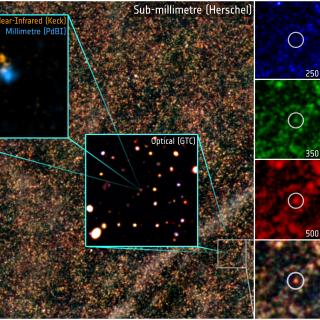Bibcode
Riechers, Dominik A.; Nayyeri, Hooshang; Burgarella, Denis; Emonts, Bjorn H. C.; Clements, David L.; Cooray, Asantha; Ivison, Rob J.; Oliver, Seb; Pérez-Fournon, Ismael; Rigopoulou, Dimitra; Scott, Douglas
Referencia bibliográfica
The Astrophysical Journal
Fecha de publicación:
2
2021
Revista
Número de citas
20
Número de citas referidas
18
Descripción
We report new observations toward the hyperluminous dusty starbursting major merger ADFS-27 (z = 5.655), using the Australia Telescope Compact Array (ATCA) and the Atacama Large Millimeter/submillimeter Array (ALMA). We detect CO (J = 2 → 1), CO (J = 8 → 7), CO (J = 9 → 8), CO (J = 10 → 9), and H2O (312 → 221) emission, and a P Cygni-shaped OH+ (11 → 01) absorption/emission feature. We also tentatively detect H2O (321 → 312) and OH+ (12 → 01) emission and CH+ (J = 1 → 0) absorption. We find a total cold molecular mass of Mgas = (2.1 ± 0.2) × 1011 (αCO/1.0) M⊙. We also find that the excitation of the star-forming gas is overall moderate for a z > 5 dusty starburst, which is consistent with its moderate dust temperature. A high-density, high kinetic temperature gas component embedded in the gas reservoir is required to fully explain the CO line ladder. This component is likely associated with the "maximum starburst" nuclei in the two merging galaxies, which are separated by only 140 ± 13 km s-1 along the line of sight and 9.0 kpc in projection. The kinematic structure of both components is consistent with galaxy disks, but this interpretation remains limited by the spatial resolution of the current data. The OH+ features are only detected toward the northern component, which is also the one that is more enshrouded in dust and thus remains undetected up to 1.6 μm even in our sensitive new Hubble Space Telescope Wide Field Camera 3 imaging. The absorption component of the OH+ line is blueshifted and peaks near the CO and continuum emission peak, while the emission is redshifted and peaks offset by 1.7 kpc from the CO and continuum emission peak, suggesting that the gas is associated with a massive molecular outflow from the intensely star-forming nucleus that supplies 125 M⊙ yr-1 of enriched gas to its halo.
Proyectos relacionados

Formación y Evolución de Galaxias: Observaciones Infrarrojas y en otras Longitudes de Onda
Este grupo desarrolla varios proyectos extragalácticos en diferentes rangos del espectro electromagnético utilizando satélites y telescopios en tierra para estudiar la evolución cosmológica de las galaxias y el origen de la actividad nuclear en galaxias activas. En el aspecto instrumental, el grupo forma parte del consorcio internacional que ha
Ismael
Pérez Fournon